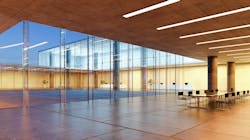The Wonderful, Widening World of LEDs
Lighting used to account for the largest share of electricity consumption in US commercial buildings. In 2003 the average was 38% but, thanks to widespread energy-saving LED technology, lighting’s share fell to 17% by 2017. As adoption of LEDs expanded, energy use dropped to 10% in the US Energy Information Administration’s most recent Commercial Buildings Energy Consumption Survey (published in 2022 based on 2018 data).
Often taking a backseat in the big energy conversations around renewables, battery storage, EVs, and other high-profile solutions, the adoption of LED lighting technology owes its success to several influences including state and federal policies, industry standards, manufacturing advances, advocacy, and incentives that make this already money-saving technology even more affordable. Barely a factor in the sustainable lighting landscape a generation ago, the impact of LEDs is now significant.
As an objective, non-profit organization, the DesignLights Consortium (DLC) worked with our efficiency program members and industry to transform the market to LEDs by encouraging the use of high quality and energy efficient products. We initially developed a consistent set of technical requirements for LEDs (i.e., solid-state lighting) that focused on high efficacy - the amount of useful light output produced per unit of electricity – and have increased those thresholds to keep pace with technology developments. Over the past decade, efficacy requirements for LED luminaires on the DLC Qualified Products Lists (QPL) have risen 30 to 40 percent, depending on product type. Recent updates to our technical requirements also included additional color quality and light distribution reporting and a requirement ensuring that virtually all QPL products are dimmable, a feature that further increases energy efficiency potential while improving user satisfaction. Pairing dimmable LED luminaires with networked lighting controls (NLCs) can increase potential energy savings by an average of about 50%!
While the LED revolution continues (eight US states recently enacted fluorescent lighting bans due to mercury content), and a new report projects global LED market growth of 8.5% by 2029), here are some other interesting facts pertaining to this game-changing technology.
- In addition to reducing energy consumption and costs for individual facilities, LEDs have a broad climate impact. According to our analysis of US Department of Energy data, the transition to LEDs has enabled North American commercial and industrial buildings to save about 1,000 terawatt hours of energy from 2010 to 2022 – resulting in avoided carbon emissions equivalent to running approximately 1,700 power plants for one year!
- LEDs can also reduce maintenance for facility managers since LED fixtures typically work for over a decade. Compared with fluorescent lighting, LEDs last at least twice as long, contain no mercury, and cut energy use by about half, according to an American Council for an Energy-Efficient Economy (ACEEE) report.
- Commercial lighting rebate programs are available in 78% of the US and rebate amounts are holding steady. In fact, LED rebate amounts are up two percent from last year, according to Briteswitch – resulting in near record high levels of average rebates for most LED products.
- There are nearly 320,000 products in dozens of unique categories on the DLC’s Solid-State Lighting (aka LED) QPL. These products meet rigorous quality and control criteria, as well as efficacy requirements that most energy efficiency programs use in setting their commercial lighting incentives.
- Newer LED products – including those listed by the DLC – encompass a range of “quality of light” features that weren’t emphasized in early LEDs. By addressing characteristics such as color performance, discomfort glare, and light distribution, they can positively affect the productivity, performance, comfort, mood, safety, and wellbeing of building occupants.
- Many new products have selectable color and/or lumen output built in to reduce the number of SKUs to be stocked by a distributor. We refer to these as “field-adjustable”. Installers simply select and set the customer’s preferred color or light output during the installation process.
LED technology continues to advance, promising better lighting quality and more energy savings. To find and compare the latest LED products appropriate for an array of lighting applications, you can search and download information on the DLC’s SSL QPL for free. Simply create a MyDLC account to start exploring!
About the Author

Liesel Whitney-Schulte
DLC Program Director Liesel Whitney-Schulte’s responsibilities include oversight of the DLC’s stakeholder outreach and engagement, communications, and membership. A member of the DLC staff since 2015, Liesel was previously responsible for operational oversight of the Solid-State Lighting Qualified Products List and technical development support. Liesel has more than 20 years of experience working on utility energy efficiency programs and collaborating with lighting designers to create programs that simultaneously fit utility goals and promote quality lighting design. She is Lighting Certified (LC) by the National Council on Qualifications for the Lighting Professions (NCQLP), on the NCQLP Board of Directors, and an active member of the Illuminating Engineering Society (IES).
